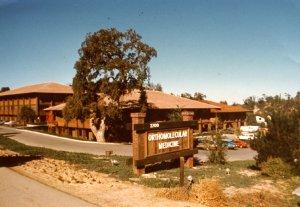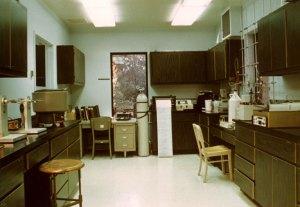
The Institute of Orthomolecular Medicine, 2700 Sand Hill Rd. Menlo Park, CA.
[Ed Note: 2013 marks the fortieth anniversary of the founding of the Linus Pauling Institute, known variously over time as the Institute of Orthomolecular Medicine and the Linus Pauling Institute of Science and Medicine. For the next several weeks, the Pauling Blog will be celebrating LPI's anniversary by publishing an in depth history of the organization. This is post 1 of 8.]
In 1969 Linus Pauling was given his own laboratory at Stanford University for his work on schizophrenia, where Art Robinson, a colleague and fellow researcher, joined him. By 1972 Pauling and Robinson had decided that their Stanford facility no longer afforded the space necessary to continue their research, and in May of that year Pauling requested that the university construct a new building to house an expanded lab for him to use.
The institution hesitated in responding, as its administration was somewhat wary of Pauling at that time, given the controversy that surrounded both his scientific interests and political activism. Pauling had recently co-authored controversial work with the Scottish physician Ewan Cameron about vitamin C and its usefulness in treating cancer, research which alienated him from much of the medical community. For its part, Stanford was very unsure about the wisdom of giving him a new lab to further that research.
Likewise, Pauling was working hard and visibly for global peace in the middle of the Cold War, activities which had long caused many people to suspect that he harbored communist sympathies. Almost as if to verify that accusation in their minds, he had been awarded the Lenin Peace Prize by the Soviet Union in 1970. Pauling was a harsh and public critic of the war in Vietnam, President Richard Nixon, US nuclear policy, and US foreign policy, which only served to legitimize some people’s doubts about Pauling’s loyalty to the United States. And if that wasn’t enough, Pauling had also publicly protested Stanford’s firing of a tenured professor known to have leftist, anti-war leanings. Stanford took these numerous activities into consideration, and decided to deny his request.
In response, Robinson suggested that Pauling step down from the Stanford faculty and move their research off campus, which they did, relocating in early 1973 to a building that Robinson had found nearby. Their new home was at 2700 Sand Hill Rd. in Menlo Park, across the street from the Stanford Linear Accelerator building. The space was in an office building shared with Kemper Insurance, a location never designed to accommodate scientific research. Nonetheless, Pauling and Robinson adapted, figuring out how to fit their lab into a footprint of less than 20,000 square feet – an area designed to hold desks and chairs instead of wet labs.

An Institute employee working at the Sand Hill Rd. facility, 1974.
Freed from their affiliation with Stanford University, Pauling, Robinson and Keene Dimick – a biochemist who agreed to help pay the rent for their new quarters – decided to form a brand new institute. On May 15, 1973, the Institute of Orthomolecular Medicine was founded as a California non-profit research corporation with the stated goal of researching biology and medicine.
(In late 1973, Pauling decided to sever all of his professional ties with Stanford, equally annoyed with the university as it seemed to be of him. However, he still retained a number of good friends amongst the faculty there, with whom he maintained close ties and corresponded frequently.)
Immediately the Institute began trying to solve a problem which would plague it for most of its existence: funding. Pauling and Robinson began by lobbying all of their friends and associates for money, trying to entice them in part by offering them largely honorific positions on the Board of Associates of their new Institute. Over thirty people agreed to help, including Francis Crick, Maurice Wilkins and a number of other Nobel laureates. The funds generated weren’t princely, but they were enough to get the Institute standing.
On the research end, the Institute began by continuing the program that Pauling and Robinson had been conducting at Stanford – mostly work on vitamin C and metabolic profiling. The new labs contained a large number of animal experiments, which took up a great bulk of the very limited space, as did the Volcano Source Field Ionization Mass Spectrometer, a new device that was being developed by Bill Aberth, a recent hire who had previously worked for SRI International.
Pauling wanted to help people with his research on vitamin C, and in 1974 he opened a small outpatient clinic which was run by John Francis “Frank” Catchpool, a doctor whom Pauling had met in 1959 while visiting Albert Schweitzer’s medical hospital in Africa. Unlike Schweitzer’s venture, the Institute’s clinic was immediately beset with major problems – liability was too high and funding was too low. Additionally, because vitamin C was cheaper than other medication, the clinic often found itself overwhelmed by destitute patients. The staff often ended up working for free, as people would arrive who were too poor to pay anything, but Cameron and other staff would still help out of sympathy and a desire to do good. Due to severe limitations on resources, the clinic closed in 1975, eight months after it opened.

Interior view of the Sand Hill Rd. facility, 1974.
As 1974 progressed, the Institute’s funding problems became increasingly ominous, exacerbated by the fact that Robinson was one of the only people on staff who was adept at fundraising. In July the Board decided to start addressing the problem by renaming the Institute of Orthomolecular Medicine. They came to the conclusion that the term “orthomolecular” was not only too difficult to explain to most potential donors, but that the term had been tainted by a recent barrage of attacks on vitamin C by the American Psychological Association. They also decided that having Pauling’s name attached to the Institute would help with funding, due to his international fame and respect.
On July 26, the Institute was renamed the Linus Pauling Institute of Science and Medicine (LPISM). The Board’s choice proved to be a good one, and more funding began to come in. Even still, it wasn’t enough, and for much of 1974 LPISM was kept afloat through financing from Pauling and Robinson’s personal accounts. Unsurprisingly this too proved to be insufficient and by early 1975 LPISM was in danger of succumbing to bankruptcy. Desperate, the Institute’s administrators were forced to exact pay cuts for all employees, but did so on a sliding scale designed to minimize the impact on workers with already low salaries.
It was at this point that Robinson confronted Pauling, accusing him of neglecting his work as president. Pauling had in fact been neglecting daily duties, boasting to the press at one point: “I don’t waste time on needless details.” Unfortunately, many of these details weren’t needless, and his administrative inattention was harming the Institute. Pauling asked Robinson if he thought he could do better, to which Robinson replied that he could. Pauling responded by making Robinson President and Director of LPISM. Still the financial issues became worse: Pauling donated 75% of his income to LPISM for the first half of 1975, and then 100% of his income in the second half of the year.
In the meantime, the Institute staff began experimenting on hairless mice. For a week before the tests, they would feed the mice food full of vitamins C and E. Next they began irradiating them with ultraviolet light to produce skin cancer and observed the effects of the high-vitamin diet on cancer growth. As a result of this research, Pauling developed a cocktail of vitamins, which he put into a single dose that he called the “Linus Pauling Super Pill.” The Institute considered marketing the pill to raise additional funds, but that plan fell through and the Pauling Super Pill was relegated to a formula in a filing cabinet.
The Institute found itself in a bad place by the end of 1975; saddled with massive financial problems, it was uncertain if it would survive. And amidst this struggle, fortunes were about to get both better and worse for the Linus Pauling Institute of Science and Medicine.
